

 |
 |
||||
| Home | Reviews | Extras | Forums |
|
Motto To Love-RuSynopsisMotto To Love-Ru is the continuing story of Rito Yuuki and the aliens that moved into his house (not to mention the other kinds of trouble he gets into on a daily basis). ReviewTim: The To Love Ru manga is, to me, a guilty pleasure. When I heard an anime was being made, I kind of looked forward to it, due to keeping the cute character designs of the manga fairly well. When I watched it, though, I was greeted with the equivalent of egg on the face. As such, I never finished it. (I did eventually finish it, and regretted it.) When Motto To Love Ru was announced, I was against seeing it. Stig and I had just finished the subpar OAVs, and having (what we thought was) the character designer of Kanokon and Ladies Versus Butlers! was like pouring salt on an open wound. Only through Stig's recommendation did I eventually see more than part of the first episode. Stig: When I worked together with Tim on the review for the original, I hadn't really read all that much of the manga yet. I had, however, read enough to know that the prequel anime had a nasty habit of adding things that never happened in the manga, or changing around the characters to the point that they became caricatures of themselves. As irony would have it, that's also the reason why I eventually checked out Motto; I had to know how badly they would screw up this one too, now that they had the character designer of Kanokon on the project. (Or so I thought at first.) So where does that leave us now? Good question. For the most part, Motto To Love Ru fixes the problem the previous To Love Ru animated series had (save for the final episode of the OAV series): they no longer stretch chapters that take six minutes to read into half-hour episodes. Now the episodes are divided into 3 7-minute chunks that nearly adapt word-by-word the manga. (This also has the unfortunate side effect of cutting certain arcs short, such as the one where Rito turns into a dog, to fit the 7 minute time limit.) With one notable exception, though; uncut nudity! 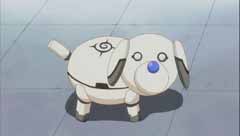 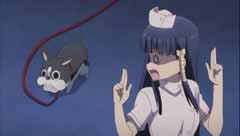 Heh. You didn't think we would actually going to post pictures of that kind of thing on a family-friendly site, did you? Shame on you. Oddly enough, though the character designs are done by Yuichi Okua, who also did them in the original T.V. series and the OAVs, somehow they feel..different. All the characters are much taller now, and the cast sees to have gotten *ahem* bigger, too. This was probably what lead to the misunderstanding about Motto having inherited Kanokon's character designer, even though we should have realized one noticeable difference; the characters in Motto To Love-Ru have noses. Despite our initial fears, one thing is absolutely clear: Motto actually improves on its own anime prequel significantly. Barring the difference in character designs and animation style, the decision to reduce manga arcs to seven minutes in order to fit three of them into each episode actually addressed one of the things we complained about with the original. Instead of being long, drawn-out affairs, each arc now moves by as swiftly as the manga it was based on. The order is completely out of whack, though, so some of them had to be altered slightly to fit in with some of the later events of the manga, like the one where Celine takes on the form of a little girl. (Which is a shame, because she was much funnier as a huge, ramen-slurping plant in Rito's backyard.) We could also mention the rampant nudity and fanservice, but this is To Love-Ru. Complaining about that would just come off as ridiculous. 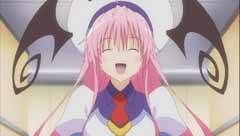  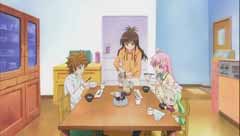 The biggest and most appreciated change, however, is that Motto chooses to play its cast more along the manga, as opposed to blowing their characterizations up to eleven. Remember when the original anime changed around Rito and Lala's meeting by adding some lame subplot about how touching a Devilukian woman's breasts is considered a proposal? Or how about Yui, the Rito-hating Neo-Nazi Class Representative? That's kind of what we're getting at; Motto seemingly refuses to hammer this nonsense in until we all look like Pinhead cosplayers. The character line-up is the same as the first series, for better or worse. There are some new characters, though, like Lala's sisters Momo and Nana, as well as Celine now being a little plant-girl. (The "how" being covered in the manga, but not in the anime.) Unfortunately, all too often the series will focus on its "lesser" characters, like Run, Momo, or that damn principal. And yes, their antics will get old in 5 minutes. (This also accounts for cast member Yami, whose continuous threats and general treatment of Rito is also getting old, though she does at least partially make up for this through her friendship with Mikan.) This is all set-off thankfully with the appearances of the other cast members, including the aforementioned Mikan, who continues being a great little sister, taking the craziness around her and her brother with a leveled head. Unfortunately, the show ends as abruptly as it starts, and does so by lumping together two short stories that might be considered milestones in the To Love-Ru manga, at least insofar that a lighthearted, generally chaotic harem manga CAN have milestones. This isn't really the anime's fault, as it ends just as abruptly and inconclusively as the original manga. Still, though, it left quite a few people both disgruntled and dissatisfied. Of course, by the time Motto hit the airwaves, the manga sequel had already started, so this might not be the death knell of even the anime. It remains to be seen whether the anime will take up the Darkness banner, given how sexually aggressive it is even compared to the original manga. As for this show... 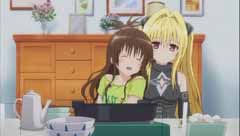 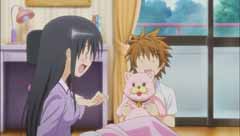 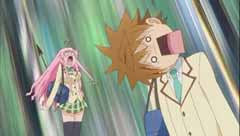 Stig: I have to say I was pleasantly surprised with this one. To Love-Ru has a generally fun cast, and to see them get changed around like they did in the original anime series just turned me off it completely. Motto is more or less the show should have been from the start. As To Love-Ru is a guilty pleasure for me, I have no problem in recommending this anime if you liked the manga. Tim: I admit to enjoying Motto To Love-Ru as well. Not only for it being way better than the earlier adaptions of the series, but for the most part being perfectly watchable (if not excessively big on fan service), despite its crude humor and a few annoying cast members. I'm still not all that big on the character design changes versus the first TV series, but that's a moot point for the most part. If you liked the manga, odds are you'll enjoy the anime. Just don't expect all your favorite chapters to show up... A closer conversion than the original, with less filler. — Stig Høgset and Tim Jones Recommended Audience: To Love-Ru continues the fine tradition of including copious amounts of naked breasts and pantyshots, occasionally with a side order of "sit on my face and tell me that you love me". This should be your main concern, as the slapstick comedy violence isn't that frequent or particularly graphic. Those who watch the uncensored version, though, will be treated to bare breasts and butts. Version(s) Viewed: Pre-licensed digital source Review Status: Full (12/12) Motto To Love-Ru © 2010 Saki Hasemi / Kentaro Yabuki / Shueisha / Motto To Love-Ru Production Committee |
 |
|
| © 1996-2015 THEM Anime Reviews. All rights reserved. |